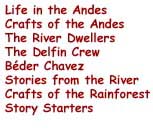|
Who are the people of Peru? What influences
have shaped their culture?
A Brief History of Peru

Like the cloth that is woven in Peru today, the history of Peru is rich
and colorful and can be traced through archeological digs to at least
20,000 years ago. During the last Ice Age, it is believed that people
crossed the Bering Strait and migrated into North, Central, and South
America. Between 12,000 and 2000 BCE, tribes of these people further
migrated and settled throughout Peru.
Between 1200 BCE and 200 CE people began to settle in villages and
began creating more "permanent" crafts, such as ceramics and weavings.
Temples and pyramids began to be constructed of carved stone. These
special buildings were used for the worship of their gods.
The Inca Empire was established by the year 1200 CE. This rich culture
unified the people of the coast with the fertile lowlands. Cuzco, as
the capital became the center of commerce and trade for the empire.
Public buildings and temples were expanded. The Incas also developed
a series of canals and roads. At its height, the Inca Empire reached
from Columbia to northern Chile.

As great as the empire was, it came to an end with the arrival of the
Spanish conquerors in the early 1500s who came in search of wealth and
prestige. The Spanish had superior weaponry and brought with them many
diseases that the Incas had no immunity against. By the middle of the
century the native population decreased from about 32 million to less
than 5 million people. Most of these deaths were from influenza, smallpox,
whooping cough, and measles. Additionally, two Inca Emperors, who were
also brothers, were fighting each other for control which weakened the
empire. All of this aided in bringing the empire to an end by 1600.
Geography
As in the time of the Inca Empire, the three geographical regions of
Peru still strongly influence how people live. The coastal desert lies
along the western edge of Peru, on the Pacific Ocean. Although the lack
of water makes it difficult to grow crops, sea life provides a plentiful
source of food. Along the region of the Andes, the hills and high mountains
make for cold, and often snowy, winters. Food must be grown on hillsides
and stored for months when little can be grown. In the northern rainforest,
the year is divided into wet and dry seasons that are almost always
warm. Animals and plants are harvested as needed from the forest as
well as from the Amazon River and its tributaries.
Language
Spanish is the official language of Peru, but many people in the country
use dialects and even other languages for their day-to-day conversations.
In the Andes, it is common to hear people speaking Quechua, a variation
of the language spoken by the Incas. Many of the words in Quechua are
used in other languages, including English. These words include puma,
llama and condor. Other people in the Andes speak Aymara.
People living in the rainforests may speak any of over 30 different
languages. Different tribes -- each of which inhabits a different section
of the forest -- may speak a different language.
You can learn more about the regions of Peru
and how people have adapted to the climate and geography by clicking
to other pages in this section.
|






